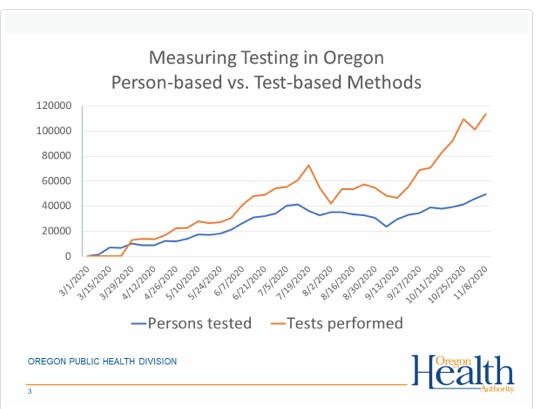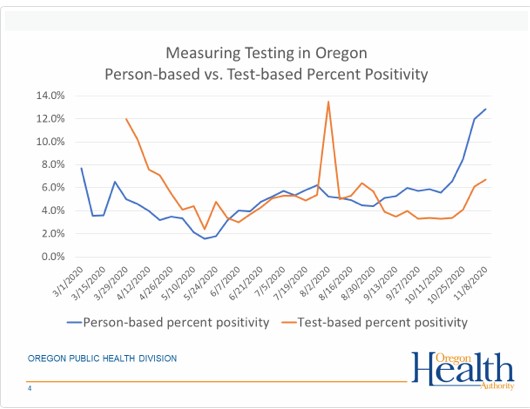And what cereal box did they get their science from?
Why on earth are we eight months into lockdowns and only now discovering the deficient testing protocols instituted by Oregon Health Authority and its director, Pat Allen? On Friday, Oregon Health Authority
announced that they would be drastically shifting the way they report tests and calculating the positivity rate of COVID-19.
The CDC uses test-based counting method which is to count all total tests administered. Up until this announcement, OHA has been using a people-based testing method. That means only counting the person instead of encounters or tests per day in the total. Oregon officials have had ample time to get this right and as a result of the latest glitch, is confidence in Oregon’s largest regulatory government agency at its lowest? The substantial lack of clarity means people will take daily reports with a grain of salt. Unfortunately, businesses are under a freeze and more is at stake than simply a lack of trust.

What this means and why this matters follows this important detail: Schools could have been open since early September when testing capacity was first ramped up. Schools could have been open in-person for two months as each district had to submit their reopening plans based on metrics which included statewide and county positivity rates. In September, the positivity rate for the state was 4%. If OHA had chosen to use the test-based measurement the CDC allowed for, schools could have been open. Many do not know this but once a school was in-person it could remain in-person even if community cases were increasing unless there was an outbreak in the actual school itself. OHA just removed this metric on
October 28th. Was this an early indicator that their testing methods were flawed, yet they instituted a freeze anyway?
By relying on positive cases only, instead of clinical diagnosis of actual infections, perhaps OHA wouldn’t have had to close down or do another lockdown, pause or freeze or mask mandate.
What are the different methods? Oregon has been using person-based testing. In lieu of a national standard, the Centers for Disease Control indicates there are three reasons why person based testing is done; either there is widespread infection or only a subset of a certain community is at risk of Covid-19 infection is being tested. Long term care residents or farm workers fit this description. The other reason is that there is a reporting process that skew the results. This happens when positive tests results are prioritized over negative test results. This prioritization has been prevalent daily in Oregon in the constant barrage of positive “casesâ€. Never recoveries. Never total tests administered and definitely not ever false positive rates.

From the CDC, “Three ways in which percent positivity can be calculated for COVID-19 laboratory tests. This infographic depicts the three ways in which laboratory percent positivity may be calculated for COVID-19 laboratory tests: tests/test, people/tests, and people/people. CDC uses the test/test method, which takes the number of positive tests and divides it by the sum of the number of positive test and number of negative tests. Some states use the people/test method, which takes the number of new people with positive tests and divides it by the sum of the number of positive tests and the number of negative tests. Then other states use the people over people method, which takes the number of new people with positive tests and divides it by the sum of the number of people with positive tests and the number of people with negative tests.â€
Another thing to note is that when using the test-based system, the CDC indicates that states should not add more than one positive. For example, if the same person had a rapid test then a lab confirmed positive, it should only be reported once.
There is little chance that counting the total tests or specimens skews the data because there has to be a balance with an unknown number of false positives or positive asymptomatic tests are done on healthy individuals who are forced to screen for work or school. Whenever community prevalence is low the chance that positive results are false, is high. Remember, reported daily positive “cases†does not mean active diagnosed COVID-19 infections.

Oregon should have been using test-based calculations months ago as it’s not one size fits all in a state with varied regional demographics. Strawberry
farm workers came from California to Klamath falls and tested positive, had zero symptoms but affected the county and statewide positivity rate.
Why does it matter? Positivity rates set the ‘Phase guidance’, gym re-openings, and more. Additionally, rapid tests aren’t distinguished from the PCR tests which are known to be less accurate. We could have used targeted mitigation instead of a statewide freeze.
A D V E R T I S E M E N T
A D V E R T I S E M E N T
It is not too late. Oregon can set a new course and be a leader. State Representative Christine Drazan said this should have been our standard from the start, “The data and the science should direct our decisions but we have to have an agency that provides reliable accurate information.â€
If Oregon truly is moving toward greater transparency perhaps we can hope to see them lower the
PCR cycle thresholds and the emergency would be over before Christmas.
Has Brown’s downfall been appointing individuals ill equipped to steer the ship? Oregon’s top Epidemiologist is not trained in epidemiology but pediatrics. The director of OHA is an economist.
Hindsight is 20/20, however, what is going on at OHA?
--Nicole DeGraff| Post Date: 2020-11-21 21:08:29 | Last Update: 2020-11-23 15:47:10 |







 What this means and why this matters follows this important detail: Schools could have been open since early September when testing capacity was first ramped up. Schools could have been open in-person for two months as each district had to submit their reopening plans based on metrics which included statewide and county positivity rates. In September, the positivity rate for the state was 4%. If OHA had chosen to use the test-based measurement the CDC allowed for, schools could have been open. Many do not know this but once a school was in-person it could remain in-person even if community cases were increasing unless there was an outbreak in the actual school itself. OHA just removed this metric on October 28th. Was this an early indicator that their testing methods were flawed, yet they instituted a freeze anyway?
What this means and why this matters follows this important detail: Schools could have been open since early September when testing capacity was first ramped up. Schools could have been open in-person for two months as each district had to submit their reopening plans based on metrics which included statewide and county positivity rates. In September, the positivity rate for the state was 4%. If OHA had chosen to use the test-based measurement the CDC allowed for, schools could have been open. Many do not know this but once a school was in-person it could remain in-person even if community cases were increasing unless there was an outbreak in the actual school itself. OHA just removed this metric on October 28th. Was this an early indicator that their testing methods were flawed, yet they instituted a freeze anyway?
 From the CDC, “Three ways in which percent positivity can be calculated for COVID-19 laboratory tests. This infographic depicts the three ways in which laboratory percent positivity may be calculated for COVID-19 laboratory tests: tests/test, people/tests, and people/people. CDC uses the test/test method, which takes the number of positive tests and divides it by the sum of the number of positive test and number of negative tests. Some states use the people/test method, which takes the number of new people with positive tests and divides it by the sum of the number of positive tests and the number of negative tests. Then other states use the people over people method, which takes the number of new people with positive tests and divides it by the sum of the number of people with positive tests and the number of people with negative tests.â€
From the CDC, “Three ways in which percent positivity can be calculated for COVID-19 laboratory tests. This infographic depicts the three ways in which laboratory percent positivity may be calculated for COVID-19 laboratory tests: tests/test, people/tests, and people/people. CDC uses the test/test method, which takes the number of positive tests and divides it by the sum of the number of positive test and number of negative tests. Some states use the people/test method, which takes the number of new people with positive tests and divides it by the sum of the number of positive tests and the number of negative tests. Then other states use the people over people method, which takes the number of new people with positive tests and divides it by the sum of the number of people with positive tests and the number of people with negative tests.â€
 Oregon should have been using test-based calculations months ago as it’s not one size fits all in a state with varied regional demographics. Strawberry farm workers came from California to Klamath falls and tested positive, had zero symptoms but affected the county and statewide positivity rate.
Oregon should have been using test-based calculations months ago as it’s not one size fits all in a state with varied regional demographics. Strawberry farm workers came from California to Klamath falls and tested positive, had zero symptoms but affected the county and statewide positivity rate.